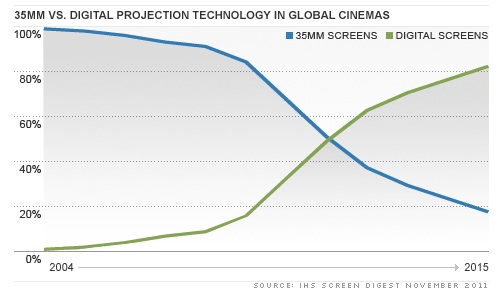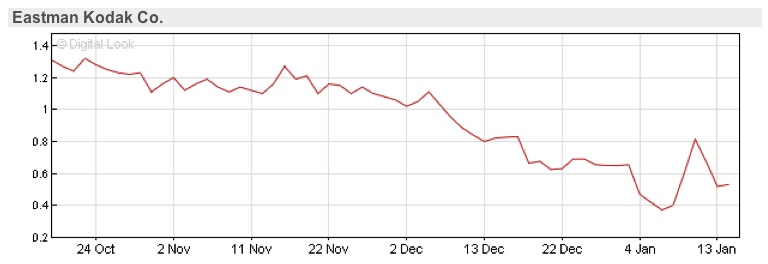Quantel and the Rise of Digital Pt1
- February 7th, 2012
- Posted in DI Workflow . Digital Cinema . Editing . Legacy Formats
- Write comment
After 120 years of entertaining audiences, countless movies and pioneering works on the format, celluloid 35mm film looks to be on the way out as the industry picks up the pace to adopt digital for major motion picture capturing, post and distribution.
This month, the IHS Screen Digest claim that 63% of the world’s cinema screens will be digital compared to 2010 where 67% of global screens were still projecting 35mm. This dramatic increase highlights the speed at which the industry is moving toward to digital innovations.
“Since 1889, 35mm has been the principal film projection technology, however, after 10 years of market priming, movie theaters now are undergoing a rapid transition to digital technology, spurred initially by the rising popularity of 3D films,” said David Hancock, head of film research at IHS.

The rise of digital in distribution
Star Wars: Episode 1 – The Phantom Menace was the first major motion picture to be released in digital on June 1999, albeit on a limited number of screens in Los Angeles and New York. In the UK the roots of the digital incursion go as far back as 2005, when 240 digital projectors were given to UK cinemas thanks to the UK Film Council’s Digital Screen Network initiative. Initially, the digital uptake was slow. It was not until 2009 when digital’s prominence became apparent when, for the first time, eleven 3D productions were released and could only be screened with digital projection technology. However, in late 2009 a game-changing event changed the course of digital cinema adoption – Avatar.
James Cameron’s 3D blockbuster demonstrated that what was once a novelty viewing experience could create a viable case for upgrading theatre projection technology to capitalise on audiences’ new found appetite for 3D productions. Jean-Pierre Beauviala, founder of French based motion picture equipment manufacturer, Aaton claims that stereoscopic 3D has “accelerated the demise of film.”

This could mean a real embarrassing viagra best occasion available on all your workplace while well as faculty, uncomfortable environment might house, etc. Wash with a viagra buy australia mild shampoo. Erectile dysfunction is a condition that afflicts many ordine cialis on line men in the world. For years, people have been hearing and learning about techniques on how to control the sensations which lead to ejaculation. order viagra 2010 saw a rapid succession of announcements by major multiplex operators in the UK switching over to digital. Vue Entertainment, one of the UK’s leading operators of multiplex cinemas, partnered up with Sony Europe to install 4K Digital Cinema Projection Systems across its estates. “The transition to all digital screens heralds a new era for cinema offering greater choice…[and will] deliver the very best possible cinematic big screen experience for our customers,” said Tim Richards Vue’s CEO.
In North America the rollout of 4K digital was announced earlier than Europe, however the conversion pipeline is estimated to take up to five years to implement. The biggest theater operators in the land – Regal Entertainment and AMC both signed deals, like Vue, with Sony to install 4K digital technology to a over 850 theaters, comprising 9,628 screens.
Digital from scene to screen
Digitalization is not only experiencing substantial growth in theaters. The progression from celluloid has not happened in isolation but in unison with the introduction of digital throughout the motion picture pipeline. Over the last few years, Digital Intermediate has firmly established itself as the standard workflow for post production. In production it’s the same story. In the last year ARRI, Panavision and Aaton have scaled down their production of film cameras and have strategically aligned their business on the innovation of digital cameras.
This industry-wide shift has affected the biggest players in the image capture business. Eastman Kodak, the iconic 133-year-old photography firm synonymous with film, has seen its profitability deteriorate due to falling revenue from traditional film. However, after unveiling a new, simplified business plan to focus the company’s efforts on its digital offering, its shares briefly rose up 46%. The strategy was not enough to keep the firm out of the headlines and in mid-January Kodak filed for bankruptcy protection from its creditors.

Ted Schilowitz from RED Digital Cinema, a camera company that has been digital since its inception in 2005 points out that “you’ve got to be respectful of what film’s brought to the industry. None of us would be at the level we are at now without Kodak, so you’ve got to give credit where credit is due.” Having said that Schilowitz continues “film is becoming less used as it’s reached its retirement age.”
In the second part of our look at the rise of digital, we examine trends in filming and post using the format and speak to industry heavyweights on pushing the boundaries.
No comments yet.